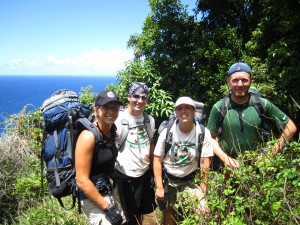If you’ve read this blog over any sort of extended time, you should notice a pattern: May to November, really good at writing frequently; December to April, really infrequent writing. I came into the winter this year with a head full of steam and several partially-written blogs. I had desires to reach out to more Occupational and Speech Therapists, and I also had the intention of voicing my strong opinions of PT-specific topics. But, as usually happens in December and January, I’ve had too much damn fun in Aspen and haven’t written a damn thing.

The mountains of Aspen have kept me aptly distracted from writing this blog.
So, it hasn’t snowed a meaningful amount in several weeks, I got a quick ski session in this morning that was reminiscent of my days back skiing on the blue ice of the Northeast, and I’m left with a full afternoon to produce something meaningful for you. After procrastinating a couple hours by clearing a couple items out of my Netflix queue, I’ve sat down at the computer to write. In my mind, I’ve abandoned the two possible topics I had intended to write about and have forgotten what my partially-written blogs from November are even about. This will be stream of thought entry, proof-reading may be marginal, and I’d like to just get some of my current thoughts out to you. In these ramblings, I hope there’s something useful about being a traveling therapist that can be a take-away for you. If not, I’m sorry – at least my blogs are short.
The football playoffs started out with a lot of different potential outcomes for me. As a Native New Englandah and now as a Colorado Resident, the prospect of a strong Broncos’ team scares the heck out of me. It seems that in most of recent history, the Pats inevitably meet the Broncos in the playoffs – rivalries are fun, until it pits you against everyone around you. This year, we snuck by, the Broncos were eliminated early and my friends and co-workers (sorry, guys) were silenced. Crisis avoided. Then, two weeks ago, I realized my Pats were up against the Indianapolis Colts – Indy is also the home of this year’s CSM conference which is to be held 3 days after the Superbowl. If the Colts got past the Pats and went on to win the Superbowl, I would be in Indy for the victory parade…. Not a pleasant thought. Luckily, the Pats have prevailed beyond the Broncos, beyond the Colts, and are on to play in the Superbowl against the defending champions, the Seattle Seahawks. The NFL has once again stirred up controversy to make a good-guy/bad-guy scenario: Last year, the terrible Richard Sherman was portrayed as an out of control brute who can’t control his emotions, this year he is the intelligent tough-guy who will be playing through injury to take on the New England cheaters. I imagine by the time most of you read this, the NFL will have cleared the Pats of any wrong doing – it was trumped up controversy, folks, the NFL choreographed the whole thing to make you care about the Superbowl, just saying.
::segue coming::

The current center piece for our living room. A Hawaiian coconut painted with the Patriots logo. Below that, a series of books from Colorado, Hawaii, and Alaska.
Anyhow, let’s move along to the topic of therapy and travel. Did I mention I would be in Indianapolis for a conference next week? For those of you who may not be in Physical Therapy and may not know, CSM is our biggest conference each year, it moves from city-to-city each February, and over 10,000 PTs, PTAs, and students attend. Everytime I attend a conference, I come away incredibly motivated and excited for the future of our profession. I’ve written in the past about the need to gain knowledge and continuing ed while traveling (Traveling Doesn’t Have to Mean Professional Sacrifice – 4/11/11). Attending this conference accomplishes learning at a very high level and so much more – hanging out with old friends, meeting new colleagues/friends, discussing the future of our profession, meeting other travelers, and having a good time.
In the past, I have felt like the opportunity of being a traveling Physical Therapist may be some sort of compromise. Traveling frequently from place-to-place has limited me in creating real traction to move forward to the next stage of life (whatever the hell that is)! The approaching of CSM and some recent conversations with friends has brought this thought of the balance between travel-life and being established to the front of my mind again. This thought apparently comes to mind frequently around this time of year (Community Chest – 3/1/14). I was speaking with a co-worker, who is also a travel PT, and she was wondering what is “next” for herself. For me, “next” usually comes in the form of a 3-month plan that my wife and I spontaneously put together over a couple beers in mid-February. (Perhaps back home to New England for a few months? (and maybe catch some Red Sox games?)) (Who uses parentheses within parentheses? (Weird.)) But, this traveler I speaking with was asking the bigger question, “What’s next in her CAREER?”
Oh man, the “C”-word for travelers: “CAREER”. This word is only surpassed by the “S”-word: “Settledown”.
The life chosen as a traveler is unconventional. Kate and I, my wife, have chosen to roam fancy-free and mostly without any agenda other than to see as many different, awesome things as we can. We’ve been at this for 8 years and aren’t done yet, but it seems that through our meanderings, some sort of career-traction is being established. 1. I have had several requests for meetings at CSM this year, mostly about and due to travel (the total of all requests for meetings in previous years is zero). 2. I’ve inserted myself into conversations legislatively about licensure issues which has opened some big doors in the last couple of months. 3. Traveling just feels good to keep doing – after all, it’s what everybody does once they are retired and no longer hindered by their work schedule. Could it be possible that a career could be made traveling? Just writing down the words makes me feel uneasy, you’d think there would be some stop to this crazy travel-life. Who knows. For now, I’m excited for the Superbowl, CSM, and the next three months – but I should come up with a solid plan for the following three months soon. The three months after that? Not important, I’m doing jobs that I like, where like, with people I like.
Whoa, well I certainly got on a roll there. Hope it wasn’t too manic for you and sorry for blabbering about the Superbowl, be thankful I didn’t go on-and-on about the Rob Gronkowski dream I had this week. I’m just glad I finally got around to the topic of travel therapy. Have a wonderful winter and I promise I have more poignant topics soon.




